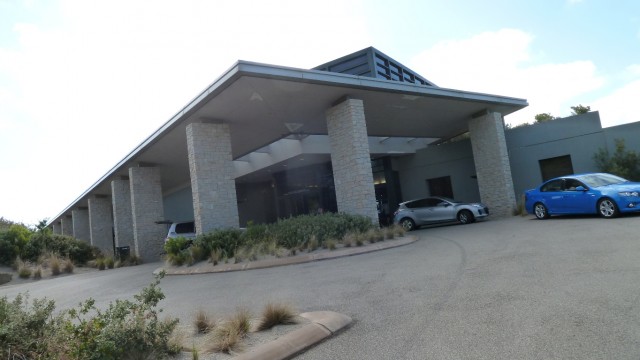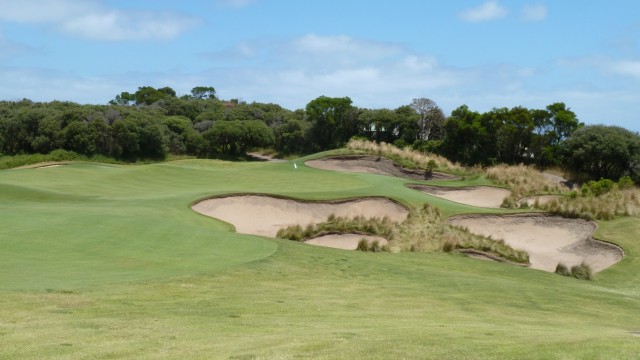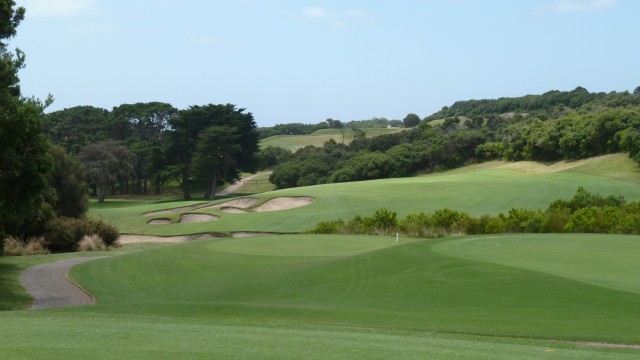
Location: Cape Schanck, VIC
Established: 1998
Architect: Robert Trent Jones Jnr
First Played: 28th Dec 2011
Last Played: 18th Mar 2018
Magazine Ratings

19 (Current)

24 (Current)
Still on my Christmas break in Melbourne, I was concentrating on playing golf in the Mornington Peninsula region. The day before I had played St Andrews Beach, up the road from The National Golf Club, which was a great introduction to golf for the nine courses which rank in the top 100 list. The National Golf Club Old Course, located in Cape Schanck was to ensure my visit to the area was memorable one.

Entrance to The National Golf Club
Driving in the gate you see the rolling hills and farmland, questioning whether there is a golf course anywhere on the grounds. The further you go in you start seeing glimpses of the course and some of the luxury residential properties on the course, although these are minimal and do not impede on the course at all. Finally you arrive to the grand clubhouse, which has quite a bit of memorabilia from some of the tournaments held and the outstanding practice facilities available, which even rival those at Augusta National.

The National Golf Club Clubhouse
The National Golf Club was first launched during the Australian Masters tournament at Huntingdale Golf Club in 1985 as an equity shareholding. It was the first new club in Melbourne in 60 years. By 1988 the Robert Trent Jones Jnr designed links style course had been completed, known now as the Old Course.

Map of The National Golf Club Old Course
In 1996 the Club had acquired adjoining property, land which was spectacular to create a natural links course amongst the sand dunes along the coastline. This lead to two further courses being created, the Moonah Course designed by Greg Norman and Bob Harrison and the Ocean course, designed by Thomson, Wolveridge and Perrot, both of which were opened in 2000. The creation of the later two courses lead to a new clubhouse being built and re-routing of The Old course.

Scorecard for the Old Course at The National Golf Club
I was playing with Harry, a member I had met the year before at Peninsula G.C. He moves between Victoria and Queensland ensuring a year round warm climate. Luckily for me he was available and we managed to play in the local competition of the day. It was great catching up with Harry and I look forward to returning to play the clubs other two courses with him, as he is quite knowledgeable on the history of the club and the course design.

Hole 1 – 312 meter par 4
Starting the round, we have a picturesque tee shot, with a lone moonah tree in the middle of the fairway. This shorter par 4 has slopes from either side working toward the middle. A large bunker to the left should be avoided.

Approach from the 1st fairway
A large swale is found short of the bunker as the fairway narrows. The green surrounds on the left slope back towards the putting surface, whilst on the right there are many bunkers. A very undulating green will be a test if you didn’t hit the practice green before the round.

Hole 2 – 394 meter par 4
The longest par 4 on the course, this straight playing hole narrows dramatically at the 270 mark. Before this there is ample room to land the ball, but avoid the bunkers to the right.

Approach from the 2nd fairway
As we get closer to the green the fairway is like a roller coaster ride, with the green eventually finishing higher than the fairway. A long bunker protects the center to left rear.

Hole 3 – 367 meter par 4 – Playing partner David teeing off
A long uphill par 4 is like climbing Mt Everest. This long hole has a dogleg to the left and is the hardest on the course. Playing over a small valley to a fairway, which almost seems to be lined with bunkers, is best suited for shots shaping right to left.

Harry doing his duties on the 3rd green
The second shot is up a massive slope to a partially obscured green. A narrowing fairway will punish anything slightly off line, but the green is quite large with two tiers, sloping from the rear to the front.

Hole 4 – 152 meter par 3
Playing from an elevated tee, the 4th, a medium length par 3 has to carry the water hazard.

The large 4th green
A large green with bunkers either side, has a spine running through the back section. A visually stunning hole, especially on a clear day.

Hole 5 – 448 meter par 5
The old 18th, this par 5 has a tee shot which must carry a hazard before reaching the fairway. Playing the first section up a hill before turning to the left. For long hitters stick to the left or the fairway may run out of room. A trap is also located on the right.

Playing partner Barry playing from the 5th fairway
The second shot is played to a fairway which is peppered with bunkers the closer we get to the green, although one lone bunker is around 100 meters out, with the fairway feeding down into it.

Playing partner Harry playing his chipshot to the 5th green
The green has a large slope leading up to it, with the slope just as big at the rear. A large spine runs through the middle of the green.

The old clubhouse near the 6th tee
Originally the clubhouse was located behind the sixth tee, which at the time was the first. With the expansion of the clubs two other courses, it was located to a more central location.

Hole 6 – 321 meter par 4
A shortish par 4, this hole was previously the first, fronting the old clubhouse. With a small dogleg to the right, the hole has ample fairway to hit, but the further left you are, the longer the second shot.

The undulating 6th green
Approaching the green there are a few mounds, which could leave you with an awkward stance. The green complex has three bunkers protecting the putting surface. There are two tiers to the green with some large undulations.

Hole 7 – 121 meter par 3
The signature hole and shortest hole for the Old Course, this par 3 plays over a valley to a wide green. One bunker is located to the right, but is the least of the problems. Spectacular views of the coastline can be seen from the tee and green.

Hole 8 – 439 meter par 5
From the 8th tee, there is a blind tee shot to the fairway below. This longish par 5 plays from a high elevated tee with the fairway split in two islands. Trees are in play on either side, but so is overshooting the first section of the fairway.

Split level fairway on the 8th
The second shot is to either a split fairway or taking on the green. One part of the fairway is at the same level as the green, whilst the lower section is level with the bottom of the green side bunkers, three of which can be found surrounding the green. The putting surface has some small contours to deal with.

Hole 9 – 367 meter par 4
A straight hole which is of medium length for a par 4. From the tee fairway bunkers can be reached on either side. The fairway has extensive undulations to contend with.

Well protected 9th green
The approach to the green will need to avoid the bunkers covering either side of the green.

Hole 10 – 489 meter par 5
Starting the back is the hardest par 5 on the course. This double dogleg starts with a turn to the left. The landing area is quite wide, but bunkers are find on the inside of the turn. Careful not to hit too far here as the fairway runs out.

A large double green is found at the 10th
The second shot will be over some rough to the second section of the fairway. To reach the green will require a long shot. Bunkers are found down the right of the fairway, but once reaching the green bunkers line either side. The 10th is a double green joining the 14th, making it quite large.

Hole 11 – 349 meter par 4
This medium length par 4 has a blind tee shot over a hill, with the fairway turning to the right. Bunkers are found on the left, with the fairway sloping to the right.

The 11th green protected by many bunkers to the right
Chances are you will have a down hill lie playing the approach. Right means getting the bucket and spade out. The green has some large slopes and undulations, but you should be used to that by now.

Hole 12 – 279 meter par 4
The shortest par 4 and the easiest hole on the course. This has a dogleg to the right, with bunkers on the other side to catch anything going through the fairway.

The 12th green leaves great views looking back along the coast
Playing up a slight slope, the rough encroaches in front of the green on one side, with bunker on the other. The green falls away at the rear. Don’t forget to look back from the green to see the view along the coast.

Hole 13 – 169 meter par 3
The longest par 3 on the course, this hole has trouble with anything slightly off line. Bunkers and heavy grass are found on either side of the hole.

The fairly flat 13th green
Long, but one of the flattest greens on the course, it can be tricky with the back section sloping away.

Hole 14 – 368 meter par 4
One of the hardest par four holes on the course, this long hole has a dogleg to the left. Playing slightly down hill from the tee, the fairway slopes to the left, but upon reaching the turning point slopes towards the green. Bunkers are in play on the inside of the turn.

The second half of the double green is found on the 14th
Approaching the other side of the double green, some large pine trees come into play, making the approach a lot narrower. There are also bunkers at the front, left and rear to avoid.

Hole 15 – 352 meter par 4
Like playing a shot from the top of the World, this highly elevated tee shot is totally exposed to the elements. There is a huge landing area, but it is critical to reach the right area. Bunkers align the end of the fairway, which is the ideal area to land. Not hitting far enough will leave a shot blocked by trees.

Massive undulations can be found on the 15th green
Finding yourself on the right side of the fairway brings a Moonah tree into play near the green. With a two tiered green it is important to land on the right portion. Deep bunkers are located at the front and rear of the hole.

Hole 16 – 149 meter par 3
This medium length par 3 plays over a valley of scrub. Anything too short, tee again. Bunkers cover much of the left side of the hole.

Large slope away on the 16th green
Being slightly short of the green may see the ball roll a far distance back. Parts of the surrounds funnel the ball back towards the green.

Hole 17 – 491 meter par 5
The longest hole on the course, this par 5 is a dogleg to the left. Looong hitters can take on the turn but there isn’t much landing area as the fairway narrows. For the safe option there is ample fairway to land the ball, but avoid the bunkers on the left.

Long fairway bunker complex on the 17th
Making our way towards the green, the main trouble, besides hitting into the trees either side, is the fairway bunkers on the right as we approach the green.

The large 17th green
This putting surface has a spine running through the middle separating it into two sections.

Hole 18 – 306 meter par 4
Finishing the round is a short par 4 with a dogleg to the right. A fairway trap is located to the left, which will make it almost impossible to reach the green. If you can shape the ball left to right, here is the time to use your magic.

Approach to the 18th green can be tricky
The approach to the green is over a few mounds and what looks like a maze of bunkers. Playing to an elevated green with deep bunkers down the right, an accurate shot is required to land on the green, especially for rear pin locations due to the narrowness.
In summary I have to admit that this has become one of my favourite golf courses in the country, so I might be prejudice in anything else I say. The condition of the course was fantastic. Tee boxes were immaculate, fairways well kept with a bit of sponginess but still having some run. Bunkers were fairly even with the sand and had almost razor sharp edges. Lastly the greens were slightly firm but had a true run.
I have had someone comment that they thought the course was like playing crazy golf. My perception is that it is about using your imagination in getting the ball to the hole, especially around the greens. It would be criminal to have the green speeds to high on these, due to the massive undulations at times, which would make it crazy. All I can say is that I can’t wait to play again and if I lived closer, wouldn’t hesitate to become a member.
The National Golf Club is a private club. The following are the only way to play at the club:
1. Introduction from a National G.C. member
2. Be an interstate or overseas visitor (contact The National Golf Club for tee times)
3. Attend an open day. Keep an eye on The Social Golf Club

